John Konrad
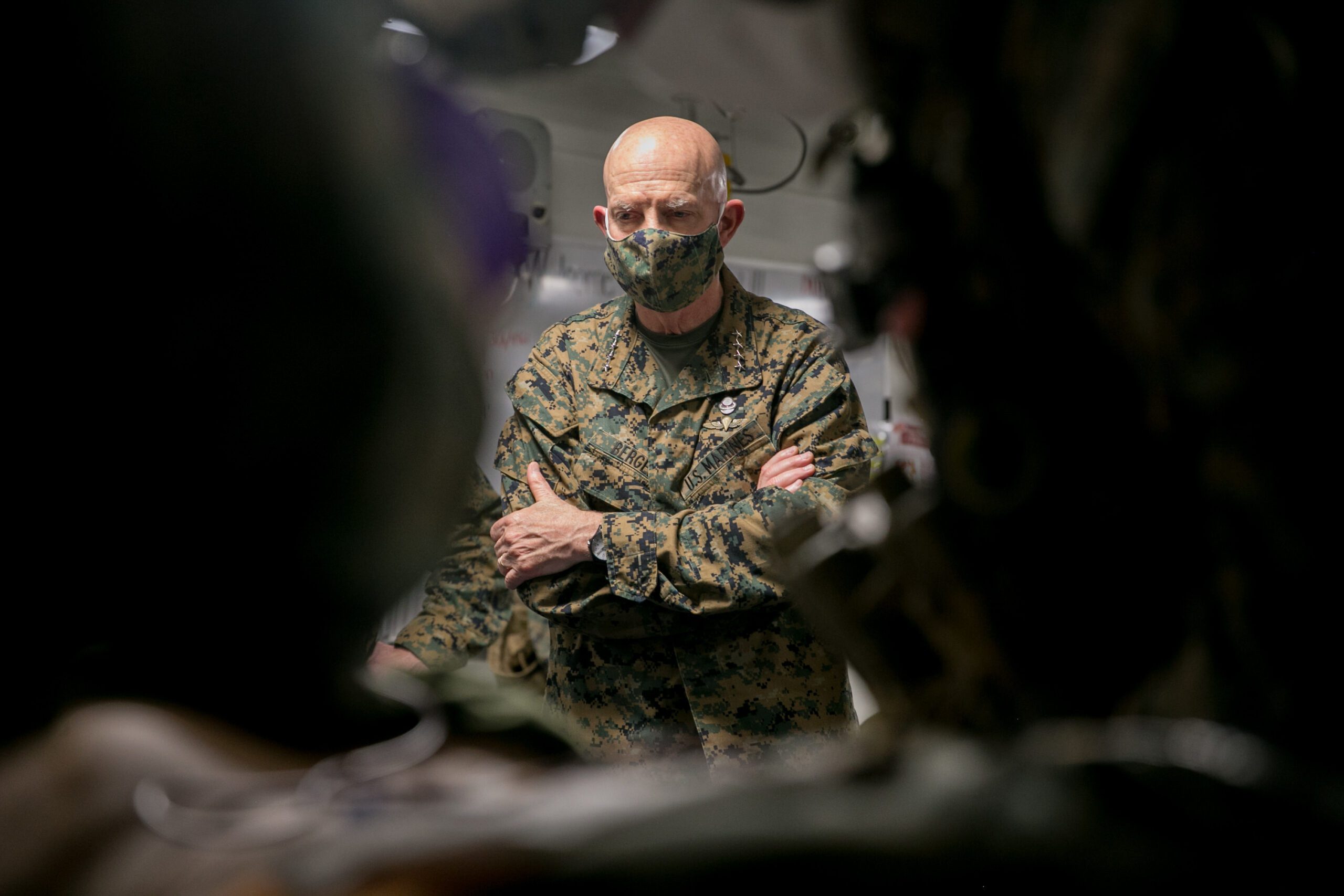 This week, the United States Marine Corps Commandant made a bold and urgent call to prioritize logistics at sea in the Pacific theater. However, it’s concerning that the rest of the US Military has placed an unreasonable emphasis on air logistics while neglecting the now skeletal remains of the US Merchant Marine. It’s time for a realistic assessment of our current logistics capabilities in the Pacific and to explore new opportunities. This article takes a full and unvarnished look at military logistics and highlights ways the US Secretary of Defense and US Secretary of Transportation can take immediate action to strengthen seaborne logistical capabilities in the Pacific.
This week, the United States Marine Corps Commandant made a bold and urgent call to prioritize logistics at sea in the Pacific theater. However, it’s concerning that the rest of the US Military has placed an unreasonable emphasis on air logistics while neglecting the now skeletal remains of the US Merchant Marine. It’s time for a realistic assessment of our current logistics capabilities in the Pacific and to explore new opportunities. This article takes a full and unvarnished look at military logistics and highlights ways the US Secretary of Defense and US Secretary of Transportation can take immediate action to strengthen seaborne logistical capabilities in the Pacific.“Infantry wins battles, logistics wins wars.” Army General John J. Pershing,
by Captain John Konrad (gCaptain) Last year, in response to House Speaker Nancy Pelosi’s visit to Taiwan, the People’s Liberation Army Navy conducted a large-scale exercise demonstrating their plans to use fast civilian ferries for an invasion of Taiwan. In light of this potential threat, it’s crucial for the US Navy to leverage insights from Ukraine and the Marine Corps’ Force Design 2030 to develop a cost-effective, yet highly capable ship that can aid allied forces in times of need. With the right approach, the US Navy can create a ship that combines the advantages of fast civilian ferries with the lessons learned from past conflicts to ensure national security and safeguard global stability but there are a lot of complexities surrounding the problem so we need to take a deep dive into the subject of sealift and war.
Don’t be caught off guard – join us as we delve into the importance of logistics and innovation in shipbuilding for national security and global stability. The future of shipping – and the billions of lives the shipping industry touches – could depend on it.
The US Military Loves RoRos
Sealift analysts have long recognized the strategic benefits of roll-on, roll-off (RoRo) car carriers. These colossal vessels are equipped with a hydraulic ramp that can be lowered onto any dock, allowing for seamless transportation of wheeled cargo, ranging from heavy-duty tanks to essential supply trucks, straight into the heart of a battlefield. The size, capacity, and ease of loading the largest RoRo ships make the per-unit cost of moving heavy items like tanks relatively small and, despite popular opinion, the military does like saving money.
Large RoRos are inexpensive and effective in peacetime but how would they perform in a large-scale war against a peer-level naval power like China?
These ships are preferred by the military over traditional container ships because they can be offloaded quickly without requiring massive container handling cranes, which can be targeted by enemy forces. However, they do have some disadvantages. These types of ships are typically slower and taller, which makes them more vulnerable to targeting. Additionally, the top-heavy design of a typical RoRo makes them intrinsically unstable and the open car decks make them susceptible to water flow if the hull is penetrated. Furthermore, the large decks make it difficult to contain smoke and fire.
Heavy weather poses a significant challenge as well. The enormous steel walls of these ships can be easily pushed by strong winds, which means that these ships, which are already slow, must often sail around storms and wait for a weather window to safely enter port.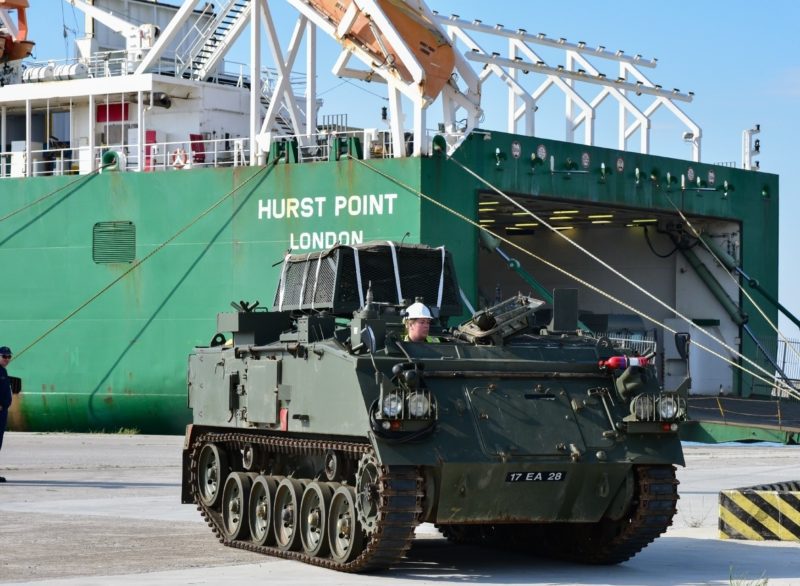 HURST POINT “RORO” discharging a light army tank in a European port. Photo by Sargent Major Fountoukidis Georgios, Greek Army via DVIDS
HURST POINT “RORO” discharging a light army tank in a European port. Photo by Sargent Major Fountoukidis Georgios, Greek Army via DVIDS
 HURST POINT “RORO” discharging a light army tank in a European port. Photo by Sargent Major Fountoukidis Georgios, Greek Army via DVIDS
HURST POINT “RORO” discharging a light army tank in a European port. Photo by Sargent Major Fountoukidis Georgios, Greek Army via DVIDSRoRo ships are also known for being challenging to salvage or lighter, as it is nearly impossible to remove critical cargo if the vessel runs into trouble. In 2019 when the RoRo MV Golden Ray ran aground in Brunswick Georgia it took a large team of salvage professionals over two years to cut her into pieces and haul away the wreckage. All of the cargo was lost.
Large RoRo ships may have been successful in the past in certain environments, but they simply aren’t suitable for the challenges posed by the Pacific. With its maze of islands, unpredictable weather patterns, and unforgiving terrain, the Pacific requires a different approach. China is a formidable opponent with advanced capabilities and a deep understanding of ocean logistics. If the US hopes to compete in this region, it needs to develop new, innovative solutions that take into account the unique challenges of the Pacific theater. Relying on outdated technology and tactics simply won’t cut it. It’s time to think outside the box and explore new possibilities for moving and repositioning military equipment.
Amphibious Ships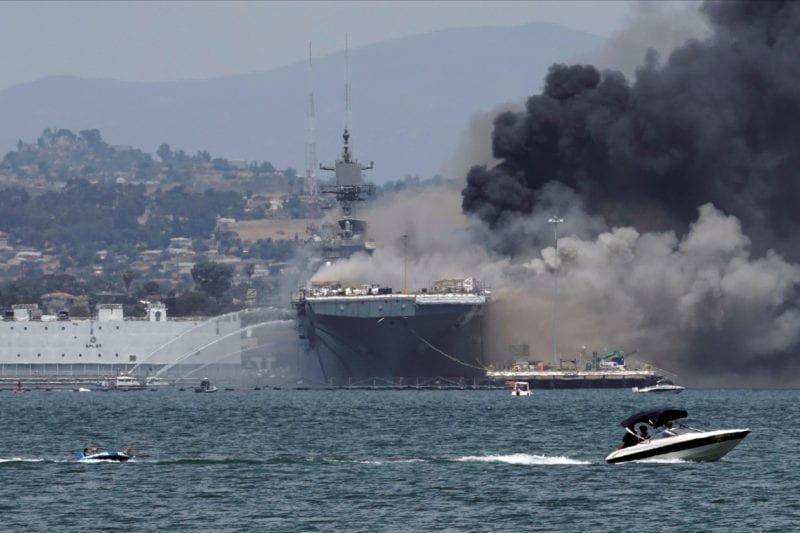 A recreational boat pulls a person on an inner tube on San Diego Bay as firefighting boats spray water onto the U.S. Navy amphibious assault ship USS Bonhomme Richard as smoke rises from a fire onboard the ship at Naval Base San Diego, as seen from Coronado, California, U.S. July 12, 2020. REUTERS/Bing Guan
A recreational boat pulls a person on an inner tube on San Diego Bay as firefighting boats spray water onto the U.S. Navy amphibious assault ship USS Bonhomme Richard as smoke rises from a fire onboard the ship at Naval Base San Diego, as seen from Coronado, California, U.S. July 12, 2020. REUTERS/Bing Guan
 A recreational boat pulls a person on an inner tube on San Diego Bay as firefighting boats spray water onto the U.S. Navy amphibious assault ship USS Bonhomme Richard as smoke rises from a fire onboard the ship at Naval Base San Diego, as seen from Coronado, California, U.S. July 12, 2020. REUTERS/Bing Guan
A recreational boat pulls a person on an inner tube on San Diego Bay as firefighting boats spray water onto the U.S. Navy amphibious assault ship USS Bonhomme Richard as smoke rises from a fire onboard the ship at Naval Base San Diego, as seen from Coronado, California, U.S. July 12, 2020. REUTERS/Bing GuanThe Navy successfully addressed several challenges of moving heavy equipment during the design of LHAs and LPDs, but with some of these amphibious assault ships nearly the size of aircraft carriers, they also have their own set of drawbacks. While watertight compartments on the lower decks enhance stability and survivability, fires on the upper levels can be challenging to extinguish, as evidenced by the Bonhomme Richard fire. Additionally, a significant amount of space is dedicated to housing marines and large engines, which are necessary to propel these massive ships at high speeds.
The Navy’s large amphibious ships are also extremely costly and take a long time to construct. The size of these vessels (and civilian RoRos) forces the Marine Corps to “put a lot of eggs in one basket.”
These problems are well known and, as part of Force Design 2030, the Corps proposed a new type of ship design – the Light Amphibious Warship (LAW) – that’s smaller, faster and cheaper to produce than big deck amphibs, but delays and cost over-runs in the production of the US Navy’s light, fast and “cheap” Littoral Combat Ship make many officers skeptical the LAW can be built this decade. The lack of shipyard capacity in the United States also means they will compete with other essential ships like destroyers, Military Sealift Command tankers, and US Coast Guard Cutters
The US Marine Corps Got Rid Of Tanks
But even if the LAW does get built on time (which seems unlikely) it does not have nearly the cargo capacity of a large RoRo or amphibious assault ships so the USMC took a drastic measure to obviate the problem. They jettisoned tanks altogether and pulled back from other heavy artillery and prepositioning programs.
What’s the point of having tanks if you can’t protect the ships that carry them to battle, can’t protect the massive harbors needed to unload them, and need the flexibility to fight on islands that can’t support heavy infrastructure? What is the point when a large slow moving RoRo full of tanks could be in the crosshairs of enemy submarines for weeks as it crosses the vast Pacific?
The USMC’s decision to divest tanks and prepositioned ships was a contentious one, with many in national security circles (including influential retired USMC Generals) loudly voicing concern. However, the Commandant of the Marine Corps, General David H. Berger, remained resolute in his belief that modernization and reorganization were necessary to meet the evolving threats and operational environments faced by the Corps. As part of this effort, he has collaborated with offshore construction companies like Hornbeck Marine to develop new logistical capabilities for contested war zones. He has also established close ties with his counterparts in island nations like the Philippines, home to the world’s largest naval force – the Philippine Merchant Marine – measured by controlled tonnage, training hours, and personnel. These partnerships are helping the Marine Corps explore new ways of projecting power and achieving strategic goals, enhancing its readiness and effectiveness in a rapidly changing global landscape.
Also Read: US Marine Corps Experiments Offshore
The decision to divest from large RoRos was not only due to cost and logistical issues, but also reflects the changing nature of modern warfare. Asymmetric warfare, which involves smaller, more agile forces using guerrilla tactics and improvised weapons to combat larger, more conventional forces, has become increasingly prevalent in recent years. In such environments, heavy equipment like tanks are less effective due to their limited mobility and increased vulnerability to IEDs and other improvised weapons. The Marine Corps’ shift towards lighter and more mobile forces better suited for modern threats and operational environments reflects a strategic move towards a more flexible and adaptable fighting force.
Furthermore, the USMC has shifted its strategic focus towards naval expeditionary warfare, which prioritizes the rapid deployment of forces from ships to land for amphibious operations. To achieve this, the Corps requires more lightweight and maneuverable forces, which can be provided by alternative vehicles such as amphibious assault vehicles (AAVs), helicopters, and unmanned aerial systems (UAS). This shift in focus has rendered heavy equipment such as tanks and prepositioned ships less effective in the face of modern threats and operational environments.
Moreover, the cost of maintaining and modernizing the USMC’s tank fleet and preposition fleet was becoming increasingly unsustainable. Divesting from heavy tanks and large ships has allowed the USMC to reallocate resources towards more relevant and effective capabilities for its current and future missions. With this shift, the USMC has been able to prioritize training and the development and acquisition of new technologies such as unmanned systems, man-portable weapons systems, and advanced communication systems that are capable of coordinating troop movement in the event satellite communication is hacked by the enemy. This has positioned the USMC to be more agile and responsive to emerging threats, while also ensuring the most efficient use of limited resources.
(It’s worth noting that the US Army, which has a different mission set than the USMC, still maintains tanks and heavy artilery and has continued to invest in modernizing and upgrading them.)
The Problem With Aviation
The US Marine Corps has a unique budget situation compared to the other services. Despite its relatively small budget, the Marine Corps is not limited to a single domain like land, air, or sea, which sets it apart from other branches. While the United States Air Force operates a few prepositioning ships, it has little interest in the ocean domain, and the current military budget practices often pit the Air Force against the Navy in a competition for resources, with the Air Force hoping to allocate more funds to the air domain. This has led the Marine Corps to seek out innovative solutions to maximize its resources and capabilities across all domains of warfare.
The US Air Force is undoubtedly a formidable force, but as the old adage goes, logistics wins wars. Unfortunately, the USAF fails to recognize that the laws of physics make air logistics in the Pacific region incredibly difficult. While transport planes have the advantage of speed, this comes at the cost of capacity. Cargo capacity is measured in pounds and inches by aviators, while ship captains measure it in thousands of tons and feet. Curiously, the USAF budget requests rarely mention the most crucial metric in shipping – the mighty ton mile. While the Air Force may be able to move light equipment quickly, its entire fleet of cargo planes combined can carry less cargo than a single modern containership. The reality is that the Air Force cannot sustain its own fighters and bombers at forward air bases without the help of merchant shipping to provide fuel and munitions. It’s clear that logistics is a game-changer, and the US Merchant Marine’s strategic importance in this regard must not be overlooked.
The US Merchant Marine, a vital component of the nation’s transportation infrastructure, has been largely overlooked by military leaders. This is a grave oversight, as the Merchant Marine plays a crucial role in supporting military operations by providing the sealift capability that is necessary to project American power across the globe. Despite its importance, the United States Maritime Service (USMS) has been relegated to the Department of Transportation, which has failed to prioritize this critical component of national security. To make matters worse, despite being a US Navy veteran who understands the importance of shipping, Secretary Pete Buttigieg has not once mentioned the USMS in the press or social media and has failed to publicly recognize the work of USMS Commandant Anne Phillips. The USMS and Maritime Administration themselves publish little publically (e.g. Phillips is in charge of supporting the shipyards that build US Navy warships but MARAD hasn’t published a basic shipyard survey in nearly two decades) so it’s difficult to understand even what problems they are working on. This lack of attention and recognition is unacceptable and could potentially have devastating consequences in times of crisis. The USMS deserves the full support of the government and military, and its contributions to national security must be recognized and celebrated.
Some believe the Marine Corps won’t need to fight for every inch in the Pacific like they did in during World War II. Instead, the US Air Force (USAF) can establish air dominance and bomb targets as they have done in recent wars. However, the bombs they carry are heavy and bombers cannot be flown back and forth across the vast expanse of the Pacific. To be effective they must operate from air bases in the western Pacific.
Fuel Distribution During War
Even more concerning than moving heavy munitions across thousands of miles of open ocean is the challenge of transporting fuel.
Currently, the US military is the world’s largest consumer of fuel, with the US Air Force alone accounting for about 60% of the Pentagon’s entire fuel budget. This dependence on fuel poses logistical challenges in a contested environment and raises concerns about the environmental impact of fuel consumption during peace. It’s crucial for the military to prioritize innovation in alternative energy sources and explore new ways to manage logistics in the Pacific theater to ensure readiness but – despite the rhetoric coming from the aerospace industry about fuel-efficient engines – the physics of moving heavy cargo high will always require the use of a disproportional amount of energy… and, because of safety and energy density requirements, no energy source known to man is capable of replacing oil in aviation for the foreseeable future. The only way to make a significant difference in DoD fuel consumption is to move cargo from high in the air to land and from the land to the more efficient sea. Therefore, to make a significant impact, DoD R&D budgets to reduce fuel use must be focused on ships, not planes, but it is unlikely the USAF will admit the simple physics behind this need.
Some might correctly surmise that the military would not be concerned with the environmental impact of using fuel during a large-scale war. They would be mostly correct (although the military would weigh the environmental consequences of highly destructive weapons like nuclear bombs) but war is unlikely to start tomorrow and, to get access to those forward air bases and ports, the military must strengthen partnerships with Pacific island nations that view climate change as a top priority. According to the National Science Foundation, a sea level rise of just 25-58 cm is predicted by the middle of this century along the coastlines of Pacific Island countries and would be devastating for islands that sit at or just above sea level.
Mid-air refueling has been a vital component of aerial warfare for decades, allowing bombers and cargo planes to stay aloft longer and extend their range. However, the issue of fuel supply remains a crucial one for the US military, particularly in the Pacific theater. While mid-air tankers can refuel planes, they need to be supplied with fuel from forward air bases close to the fight. Unfortunately, such bases require a steady supply of aviation fuel, which the military currently buys on the open market. Recent events in Europe have highlighted the vulnerability of fixed fuel production and transport facilities (e.g. refineries and pipelines) in the broad vicinity of hostile forces.
The United States has the capability to produce enough fuel to fight a war in the Pacific, but the challenge lies in transporting that fuel to the forward air bases. This is where ships come in – without them, the fuel simply cannot be moved efficiently or effectively. Even more, ships are now required more than ever before due to the recent closure of the military’s massive Red Hill fuel tanks in Hawaii. The importance of logistics in warfare cannot be overstated, and the need for a reliable and efficient fuel supply chain is paramount.
Today, the world is facing an energy crisis, not due to a lack of supply, but rather a shortage of ships to manage the additional ton miles required to replace Russian oil. While this is a relatively small conflict in the Atlantic, the Pacific Ocean is much larger and presents a much greater challenge. If the United States were to go to war with China, moving fuel safely across the Pacific would become the biggest logistical challenge the US has faced since World War II. This highlights the critical importance of investing in naval and commercial shipbuilding, in partnership with shipyards in other countries, to ensure safe shipping and prevent potentially catastrophic events in times of crisis. The ability to maintain a steady supply of fuel and ammunition is vital to military operations and must be a top priority for national security.
Air Superiority And Ukraine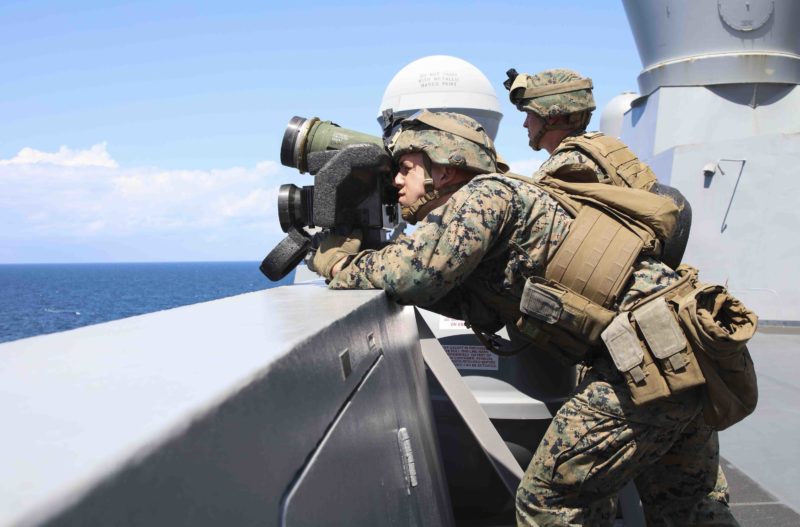 Marine Pfc. Matthew Bell aims an FGM-147 Javelin as part of a simulated small boat attack on the amphibious transport dock ship USS Arlington (LPD 24) (U.S. Navy photo by Brandon Parker/RELEASED)
Marine Pfc. Matthew Bell aims an FGM-147 Javelin as part of a simulated small boat attack on the amphibious transport dock ship USS Arlington (LPD 24) (U.S. Navy photo by Brandon Parker/RELEASED)
 Marine Pfc. Matthew Bell aims an FGM-147 Javelin as part of a simulated small boat attack on the amphibious transport dock ship USS Arlington (LPD 24) (U.S. Navy photo by Brandon Parker/RELEASED)
Marine Pfc. Matthew Bell aims an FGM-147 Javelin as part of a simulated small boat attack on the amphibious transport dock ship USS Arlington (LPD 24) (U.S. Navy photo by Brandon Parker/RELEASED)The use of planes in military operations is undoubtedly crucial – aircraft remain a powerful tool and I do not ascribe to the recently popular theory that aircraft carriers are obsolete – but it’s time to reconsider their absolute necessity in all military operations and we must find better ways to resupply them. While Air Force Generals may object to rethinking the absolute necessity of air power, there is one nation that has been successfully battling a global superpower without the support of air power – Ukraine. Their success can be attributed to their use of small portable anti-air weapons that have effectively denied Russia the use of the air.
This paradigm shift challenges the traditional belief that air superiority is the key to military victory. It’s time for the military to reassess its reliance on air power and consider alternatives.
Furthermore, the cost of maintaining and operating a massive fleet of planes is a heavy burden on military budgets. In an era of increasing fiscal constraints, it’s time to explore more cost-effective options. Investing in smaller, more agile forces equipped with modern technology could prove to be a more effective and efficient use of resources.
It’s time to acknowledge the limitations of air power and embrace new approaches that prioritize innovation and adaptability. The lessons learned from Ukraine’s successful resistance against a global superpower should serve as a wake-up call for military leaders to reassess their strategies and consider new ways to achieve victory in modern conflicts.
Air superiority is undoubtedly a critical advantage in warfare, and the investment in both the USAF and USN aircraft carriers is well worth it. However, it is essential to recognize that air defense must also include the protection of merchant ships delivering fuel and munitions to forward-operating aircraft. To ensure this, smaller and more portable air defense systems must be distributed quickly throughout the Pacific. It is also crucial to defend the sea lanes, as adversaries can install new portable anti-tank and anti-air missiles aboard their fleet of merchant ships.
China Is Already Doing It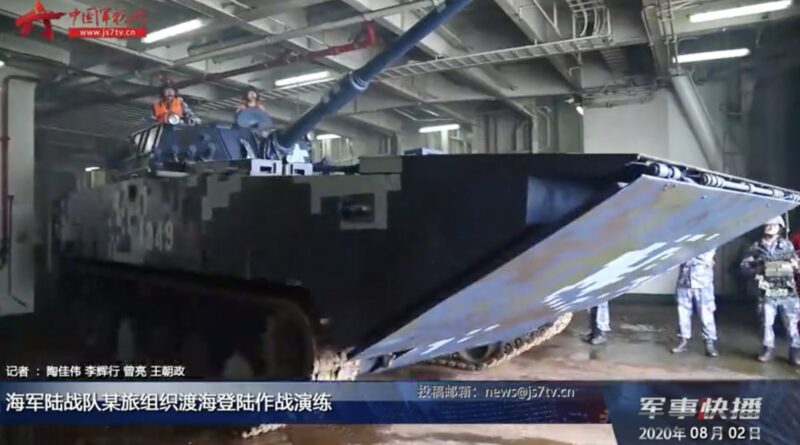 A Chinese amphibious armored vehicle leaving the car ferry Bang Chui Dao in 2020. CCTV image via USNI
A Chinese amphibious armored vehicle leaving the car ferry Bang Chui Dao in 2020. CCTV image via USNI
 A Chinese amphibious armored vehicle leaving the car ferry Bang Chui Dao in 2020. CCTV image via USNI
A Chinese amphibious armored vehicle leaving the car ferry Bang Chui Dao in 2020. CCTV image via USNIIn this, the US is far behind. Beijing already registers a significant number of merchant ships under the Chinese flag ( 4,569 as of January 1, 2020) while the United States has less than 100 in international service and a much smaller number in the Pacific.
“Civilian shipping is the central feature of the PLAN approach to an invasion of Taiwan,” said Lonnie Henley, a former Rhodes Scholar and senior Army intelligence officer, who investigated the integration of commercial shipping and China’s seafarers with the People’s Liberation Army Navy. “The PLA has spent over two decades developing the bureaucratic apparatus, laws, and regulations to organize, train, and manage this force (of civilian seafarers). This seems to be how Chinese leaders, civilian and military, think the PLA should function, leveraging the enormous resources of China’s civilian economy to support military operations.”
The use of man-portable weapons requires military weapons and communication training. Training the Chinese Merchant Navy might already have.
The war in Ukraine has brought to light the importance of logistics and small, portable weapon systems. The question arises, how can one maintain ocean logistics chains against a potential adversary like China? The answer is simple, use the enormous size of the Pacific to your advantage and move logistics via a network of widely distributed ships. However, the US military would have trouble doing this today because the US Merchant Marine has fewer than 90 ships operating overseas (far fewer in the Pacific)… huge targets that steam at slow speeds. In situations where speed is of the essence, which is often the case, Air Force force transportation quickly becomes over-extended or denied, leaving only one alternative: more capacity in the system and greater distribution.
To achieve the speed of air transport, we need to rethink ocean combat logistics. There is only one alternative to speed and that is more capacity in the system and greater distribution. Ships will never achieve the speed of air transport but if you have enough of them strategically distributed over a geographic area… they can arrive in port quickly. This is how Uber achieves greater speed. They don’t tell drivers to exceed the speed limit. Rather they recruit more divers and encourage them to “spread out” across the city.
America and its allies need more smaller, lower-cost ships that can steam at higher speeds and in a distributed nature. We need fast ferry preposition ships spread out across the Pacific. This is the only way to ensure that we have enough strategically distributed capacity to achieve a similar speed to air transport.
The Fast Ferry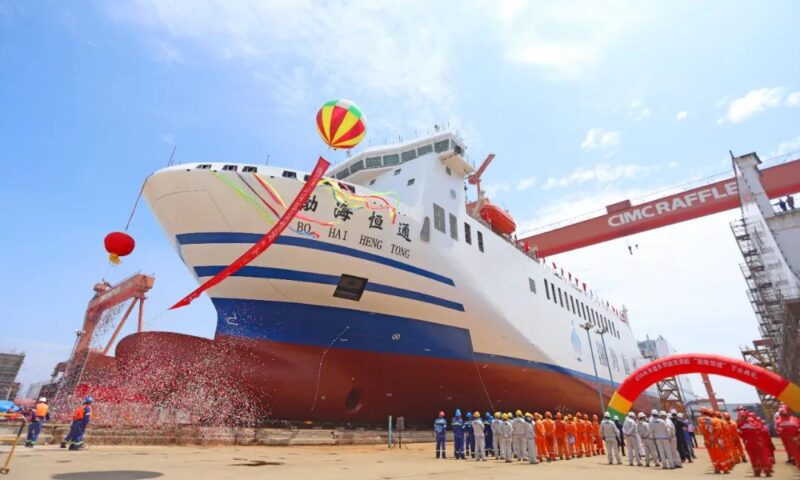 Bo Hai Heng Tong fast ferry launched in 2020. Image via US Naval Institute
Bo Hai Heng Tong fast ferry launched in 2020. Image via US Naval Institute
 Bo Hai Heng Tong fast ferry launched in 2020. Image via US Naval Institute
Bo Hai Heng Tong fast ferry launched in 2020. Image via US Naval InstituteThe United States has experimented with fast ferry designs including the failed Hawaii SuperFerry and the Spearhead class expeditionary fast transport ships operated by Military Sealift Command. Like the infamous Littoral combat ship, however, these ships featured aluminum construction, jet propulsion, and advanced engine and environmental systems that have resulted in lingering problems.
China has taken a different approach by opting to replicate successful European ferry designs, instead of developing a new vessel with sophisticated systems and cutting-edge technology. By making simple changes like adding a helideck, China has successfully incorporated these ferries for dual use, which not only lowers the cost but also ensures that the design is commercially viable. Moreover, these ferries have been utilized to transport civilians across the entrance to the Bahai sea, showcasing their versatility in different scenarios.
“China’s roll-on/roll-off ferries are very well-suited to support”any invasion of Taiwan,” defense analyst Thomas Shugart told USNI last month “Civilian augmentation will be essential, if not providing the majority of the required sealift capacity.”
Lessons From Boeing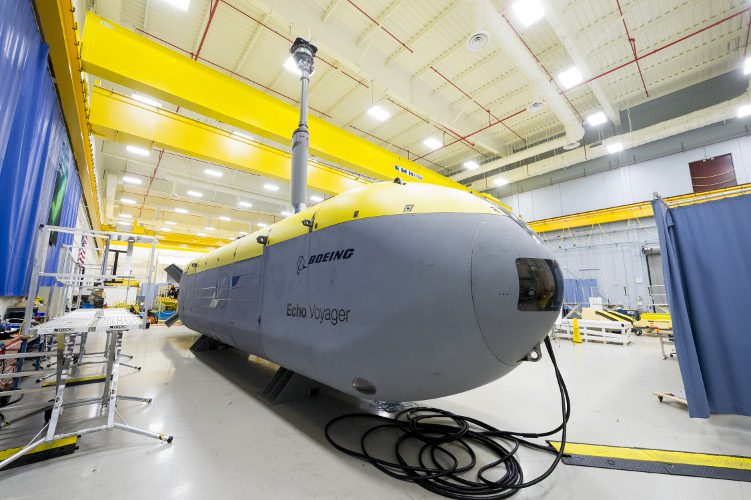 Pictured is the Echo Voyager. The Orca is based on Boeing’s 50-ton Echo Voyager, an experimental drone that was designed to cruise underwater for months at depths of as much as 11,000 feet (3,400 meters) on anti-submarine, mine-sweeping and other missions. (Boeing photo)
Pictured is the Echo Voyager. The Orca is based on Boeing’s 50-ton Echo Voyager, an experimental drone that was designed to cruise underwater for months at depths of as much as 11,000 feet (3,400 meters) on anti-submarine, mine-sweeping and other missions. (Boeing photo)
 Pictured is the Echo Voyager. The Orca is based on Boeing’s 50-ton Echo Voyager, an experimental drone that was designed to cruise underwater for months at depths of as much as 11,000 feet (3,400 meters) on anti-submarine, mine-sweeping and other missions. (Boeing photo)
Pictured is the Echo Voyager. The Orca is based on Boeing’s 50-ton Echo Voyager, an experimental drone that was designed to cruise underwater for months at depths of as much as 11,000 feet (3,400 meters) on anti-submarine, mine-sweeping and other missions. (Boeing photo)The Navy’s assertion that shipyards have reached their capacity for new ship construction has been met with skepticism by some shipyard executives, who argue that there is still plenty of available capacity to build new ships. However, even if additional shipyard capacity is available, expanding rapidly may prove difficult without finding ways to build ships more efficiently and cost-effectively.
To meet the growing demand for new ships, innovative shipbuilding techniques may need to be implemented, such as modular construction and advanced automation. These techniques have been successful in other industries and could potentially reduce the time and cost required to build new ships. Additionally, partnering with private shipyards and international shipbuilders could help alleviate capacity constraints and speed up the construction process.
Investing in new shipbuilding technologies and processes will not only help address current capacity constraints but also make the Navy more agile and responsive in the future. By embracing new ways of building ships, the Navy can increase its fleet size and capability while also keeping costs under control.
But how do we learn to implement technology, processes, and partnerships?
Some large American shipyards have been slow to adopt new manufacturing approaches, unlike Boeing, which has embraced collaboration to reduce costs. Recognizing that it is not cost-effective to build everything at its main plant, the company has partnered with others across the nation and internationally to design and produce critical parts. As an example, a plane may be assembled in Washington, but its interior may be designed in the UK, its engine built by Pratt & Whitney in New England, and its electronics sourced from Raytheon in North Carolina. The Navy could benefit from a similar approach to shipbuilding, maximizing efficiency and reducing costs by collaborating with partners across the country and around the world.
While near-sourcing and avoiding potential adversary supply chains is crucial, it’s equally important to focus on utilizing proven designs and minimizing the amount of time a hull spends in drydock. By doing so, the Navy can significantly reduce costs and increase efficiency, which would enable them to maintain a strong and agile fleet that can quickly respond to emerging threats. The key is to leverage innovative manufacturing processes and technologies already being used in Korean shipyards to streamline shipbuilding and maximize productivity. This will require collaboration between government agencies, shipbuilders, and suppliers across the borders of allied nations. Ultimately, designing a more distributed process similar to that used by Boeing (or foreign car manufacturers like Toyota who have opened plants in the United States) will help ensure that the Navy has the resources it needs to defend the nation and maintain its global presence.
Lessons From NASSCO AND Philly The Isla Bella under construction at NASSCO, with the second Marlin-class, Perla Del Caribe, alongside. Photo credit: NASSCO
The Isla Bella under construction at NASSCO, with the second Marlin-class, Perla Del Caribe, alongside. Photo credit: NASSCO
 The Isla Bella under construction at NASSCO, with the second Marlin-class, Perla Del Caribe, alongside. Photo credit: NASSCO
The Isla Bella under construction at NASSCO, with the second Marlin-class, Perla Del Caribe, alongside. Photo credit: NASSCOThere is still lots more that can be done to improve efficiency and reduce costs but it all starts with using proven ship designs, rather than bending USMC requirements for a ship like LAW to the DoD acquisitions process and requests of politicians.
In addition to modular construction, the Navy could partner with foreign shipyards like Samsung Heavy Industries and suppliers to share expertise and resources, as well as incorporate proven designs from other countries. Ultimately, a combination of proven designs, modular construction, and increased collaboration could help the Navy build ships faster, cheaper, and with greater efficiency, enabling it to maintain a strong and agile fleet capable of responding to emerging threats.
To some extent, this is already being done. NASSCO currently uses proven ship designs sold by Korean firms. Philly shipyard has taken this one step further. When building the National Security Multi-Mission Vessel – which are being built on time and close to budget – MARAD outsourced the project management to Tote Maritime who subcontracted much of the work to our allied shipyards in South Korea. These overseas yards not only provided proven designs and engineering support to Philly but arranged the consolidation and packaging on much of the equipment and supplies. The Korean yards also manage the logistical software and processes remotely to ensure the building process does not get delayed.
The next logical step in the process is to have entire hull sections fabricated in Korea and then towed to US shipyards for final assembly and outfitting. By doing this smartly, US shipyard workers can keep their jobs while increasing throughput. Increased throughput would lead to higher shipyard profits, allowing them to invest in a greater capacity.
Korean shipyards would also benefit by retaining jobs that are currently being lost to China.
(This could be done with Korea Navy ships being built by Daewo)
Sealift Lessons From Ukraine
Since the start of the Ukraine conflict, the US Transportation Command (Transcom) has conducted 61 seaborne voyages to transport over 361.2 million pounds of equipment to Ukraine, using a combination of Military Sealift Command, US Ready Reserve, and commercial ships. These voyages involved RoRos and container ships, which were ideal for moving large and heavy equipment – such as 282 artillery systems, 201.9 million rounds of small arms, and over 1 million artillery rounds – across the uncontested waters for the Atlantic.
However, Transcom also chartered 826 flights to transport smaller, lighter, and technologically advanced weapons, including 111,000 man-portable anti-armor systems like the Javelin, 1,500 air defense missiles like the Sparrow, and 47 portable radar systems. These flights had a high carbon footprint, high cost, and limited capacity. To put this in perspective, the entire USAF heavy lift plane fleet can carry less than a single Maersk ultra-large container ship.
Despite being expensive and having limited capacity, air transport was deemed essential due to the effectiveness of these weapon systems against Russian assets and the need to move them to the front lines quickly. However, it is important to explore alternative means of transportation that are more cost-effective and have a lower carbon footprint.
Logistics As Deterrence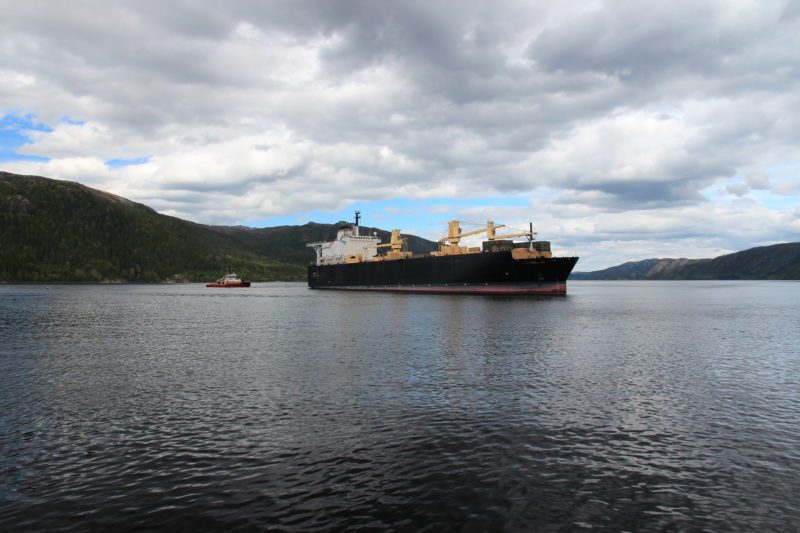 NORWAY — USNS 1st LT Baldomero Lopez, a Military Sealift Command prepositioning vessel, pulls into the Port of Hammersodden, Norway, June 6. Lopez was supporting the Marine Corps Prepositioning Program – Norway, known as MCPP-N, with the delivery of supplies and equipment. MCPP-N enables the rapid deployment of a large, credible, and balanced force to support its NATO allies and partners. (Photo by Daniel Burton, MSCEURAF operations specialist)
NORWAY — USNS 1st LT Baldomero Lopez, a Military Sealift Command prepositioning vessel, pulls into the Port of Hammersodden, Norway, June 6. Lopez was supporting the Marine Corps Prepositioning Program – Norway, known as MCPP-N, with the delivery of supplies and equipment. MCPP-N enables the rapid deployment of a large, credible, and balanced force to support its NATO allies and partners. (Photo by Daniel Burton, MSCEURAF operations specialist)
 NORWAY — USNS 1st LT Baldomero Lopez, a Military Sealift Command prepositioning vessel, pulls into the Port of Hammersodden, Norway, June 6. Lopez was supporting the Marine Corps Prepositioning Program – Norway, known as MCPP-N, with the delivery of supplies and equipment. MCPP-N enables the rapid deployment of a large, credible, and balanced force to support its NATO allies and partners. (Photo by Daniel Burton, MSCEURAF operations specialist)
NORWAY — USNS 1st LT Baldomero Lopez, a Military Sealift Command prepositioning vessel, pulls into the Port of Hammersodden, Norway, June 6. Lopez was supporting the Marine Corps Prepositioning Program – Norway, known as MCPP-N, with the delivery of supplies and equipment. MCPP-N enables the rapid deployment of a large, credible, and balanced force to support its NATO allies and partners. (Photo by Daniel Burton, MSCEURAF operations specialist)The success of Ukraine in the ongoing war highlights the critical role played by the military logistical supply chain, heavily reliant on the US Merchant Marine ships to move heavy weapons and the supply of smaller, advanced weapon systems like the Sparrow via airlift. However, it raises the question of what could have happened if the US Military had supplied these weapons at the onset of the war. Would it have made Putin think twice before initiating the conflict?
In a class about the Ukraine war, Yale professor Timothy Snyder said the only people who correctly predicted that Russia would invade Ukraine were a handful of logistics professionals. What was their trick? They noticed that Russia had not only sent troops to the border but also began stockpiling fuel and ammunition in the weeks leading up to the invasion. Few militaries are willing to haul large amounts of heavy ammo they don’t intend to use on training missions.
On the other hand, some US military experts predicted that the US would not intervene significantly in the Ukraine conflict. They based this prediction on the occasional Automatic Identification System (AIS) signals from the prepositioning ships in Diego Garcia, indicating that the fleet had not set sail for the Suez Canal.
These ships hold a massive amount of equipment, supplies, and ammunition, enough to support an entire brigade of 17,000 troops for 30 days. It would have been impossible to airlift this amount of equipment in the short window between the build-up of Russian troops and the invasion.
Had these ships set sail before the invasion, could it have deterred Russia? We will never know for sure. Like all good deterrence, success is only known when it works. However, if it had worked, it could have saved thousands of lives and billions of dollars.
“Logistics is a map of human intent,” said logistics expert Ross Kennedy in a recent video. “It’s also a signal of what you are not willing to do.”
Snow Mobile Widely recognized as one of the U.S. Air Force’s best jet pilots in the 1950s, John Boyd wrote his own combat flying manual, which would subsequently be adopted by air forces around the world. (Courtesy of the Boyd Family)
Widely recognized as one of the U.S. Air Force’s best jet pilots in the 1950s, John Boyd wrote his own combat flying manual, which would subsequently be adopted by air forces around the world. (Courtesy of the Boyd Family)
 Widely recognized as one of the U.S. Air Force’s best jet pilots in the 1950s, John Boyd wrote his own combat flying manual, which would subsequently be adopted by air forces around the world. (Courtesy of the Boyd Family)
Widely recognized as one of the U.S. Air Force’s best jet pilots in the 1950s, John Boyd wrote his own combat flying manual, which would subsequently be adopted by air forces around the world. (Courtesy of the Boyd Family)How does innovation happen? How can we reconcile the need for faster speeds to supplement airlift, the effectiveness of smaller weapons systems, and the reliance on large prepositioning ships and the USMC’s new logistics ships design?
USAF Colonel John Boyd, the father of the F-16 and a pioneer of the Marine Corps’ maneuver warfare strategy, often used the snowmobile as an analogy for the development of effective weapons systems. According to Boyd, innovation is born out of the process of “Destruction and Creation.”
Boyd said there is nothing “new” about the snowmobile. It was invented by someone who broke down the following parts:
1) A small motorboat frame
2) A pair of waterskis
3) Treads from a tank
By destroying the original objects and reconstructing them creatively the snowmobile was born.
Inventing PPOFF
If we relate that concept to shipbuilding we can take elements of each design and create something entirely new.
1) Fast Ferry Hull from the North Sea
2) The concept of Dual-Use functionality from China
3) Eliminating heavy tanks and artillery from Force Design 2030
4) Equipping the vessel with lots of man-portable weapons and high-tech systems that have proven effective in Ukraine
5) Prepositioning
6) Detterance
Together, these ideas create the concept of the PPOFF, or what I will refer to as the Pre-Positioned Off-the-shelf Fast Ferry. Here’s how it works: instead of building purpose-built ships, we utilize conventional off-the-shelf designs of sturdy North Sea ferries from our Korean partners. Only minor modifications may be made, as it is important not to add unnecessary requirements or unproven technology to the design – following the lesson Boyd learned in designing the F-16 – less is more.
Instead of being loaded with heavy tanks and heavy munitions, the PPOFF would be loaded with man-portable and high-tech systems prepositioned and distributed across the Pacific.
These fast ferries could be leased at a discounted rate to Washington State Ferries, but a better option would be to employ them as a fast prepositioning fleet, capable of supplying Marines or future allies who are facing harassment from adversaries.
Launching an entire squadron of prepositioning ships from Diego Garcia could still be a powerful tool of deterrence, but having a fleet of PPOFFs stationed around the world could be an effective warning shot that provides real capability for friendly forces in the critical early stages of battle.
In addition, loading up a fleet of fast ferries would require a steady stream of weapon systems such as Javelins, Sparrows, and HIMARS. This forward signaling of demand would help encourage weapons manufacturers to develop more manufacturing lines and increase the supply of these valuable weapon systems.
What’s Next For Sealift?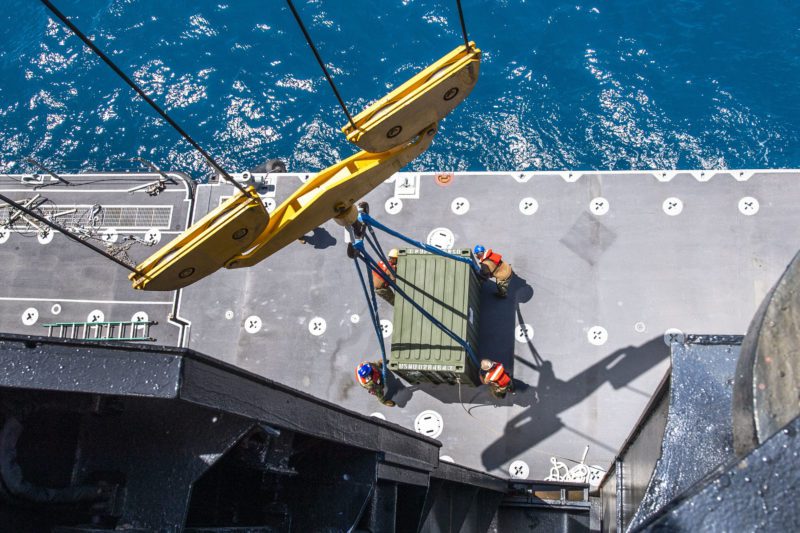 191114-N-CO914-1036 DIEGO GARCIA, Sailors attach a container to slings to be lifted by crane from an Improved Navy Lighterage System (INLS) onto Military Sealift Command Bob Hope-class roll-on roll-off vehicle cargo ship USNS Seay (T-AKR 302). (U.S. Navy photo by Nathan Carpenter)
191114-N-CO914-1036 DIEGO GARCIA, Sailors attach a container to slings to be lifted by crane from an Improved Navy Lighterage System (INLS) onto Military Sealift Command Bob Hope-class roll-on roll-off vehicle cargo ship USNS Seay (T-AKR 302). (U.S. Navy photo by Nathan Carpenter)
 191114-N-CO914-1036 DIEGO GARCIA, Sailors attach a container to slings to be lifted by crane from an Improved Navy Lighterage System (INLS) onto Military Sealift Command Bob Hope-class roll-on roll-off vehicle cargo ship USNS Seay (T-AKR 302). (U.S. Navy photo by Nathan Carpenter)
191114-N-CO914-1036 DIEGO GARCIA, Sailors attach a container to slings to be lifted by crane from an Improved Navy Lighterage System (INLS) onto Military Sealift Command Bob Hope-class roll-on roll-off vehicle cargo ship USNS Seay (T-AKR 302). (U.S. Navy photo by Nathan Carpenter)The United States Military’s lack of defensive capabilities in its Military Sealift and Ready Reserve fleets, as well as US Coast Guard cutters, is a cause for concern. While significant investments have been made in man-portable defensive weapons systems for the US Army and air weapons systems for the US Air Force, the importance of developing new sealift technology and strategies in a rapidly changing world has mostly been ignored by US military planners.
Recent events such as the current energy transportation crisis, Black Sea hostilities, and port congestion crisis have highlighted the critical role of shipping in global security. In the event of war in the Pacific, the importance of safe shipping cannot be overstated. Without it, millions of lives would be at risk, and battles will be lost.
Prioritizing shipping through significant investments in naval and commercial shipbuilding is not a realistic goal, but the United States can partner with shipyards in Korea, Japan, and Germany to produce small and medium-sized ferries that are fast and sturdy. Portable defensive systems developed by companies such as Raytheon can be tested and implemented aboard these Pre-POsitioned Fast Ferries.
This acquisition deal would require the aerospace and missile lobby to produce more weapons to store aboard the fleet of PPOFFs. While the United States military may not have the resources to prioritize shipping, thinking like US Marines and focusing on innovative solutions can help improve the country’s defense capabilities.
Conclusion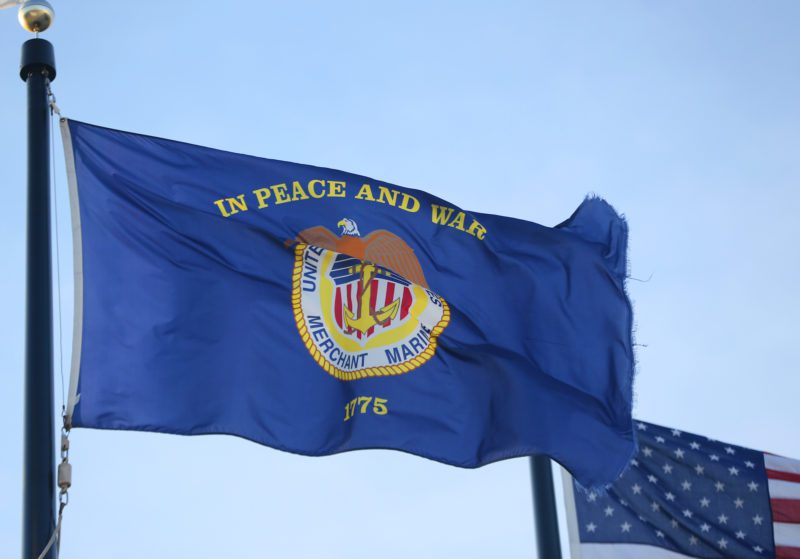 Flag of the United States Merchant Marine. Photo: Leonard Zhukovsky/Shutterstock
Flag of the United States Merchant Marine. Photo: Leonard Zhukovsky/Shutterstock
 Flag of the United States Merchant Marine. Photo: Leonard Zhukovsky/Shutterstock
Flag of the United States Merchant Marine. Photo: Leonard Zhukovsky/ShutterstockIn conclusion, the US Marine Corps has made the decision to divest from heavy equipment such as tanks and large prepositioning ships, in favor of lighter and more mobile forces that are better suited for modern threats and operational environments. The Corps has been shifting its focus towards naval expeditionary warfare, which emphasizes the ability to rapidly deploy forces from ships to land and conduct amphibious operations. This has led to the proposal of a new type of ship design – the Light Amphibious Warship (LAW) – that’s smaller, faster, and cheaper to produce than big deck amphibs. Additionally, the article suggests that to achieve greater speed in ocean combat logistics, the US and its allies also need a greater amount of smaller, lower-cost proposition and sealift ships, capable of steaming at higher speeds. By adopting such an approach, the US could improve its logistics chains and better protect its forces in the event of a conflict.
Air combat and logistics have an uncertain future but the aerospace lobby continues to be powerful, influential, and well-funded. If we are going to move forward we must learn from, and not fight, the aerospace industry. Lessons from Boeing and Aker have demonstrated the benefits of collaborating across nations for design work and critical parts to minimize the time and cost of construction. The article also emphasizes the significance of logistics as deterrence and the role of prepositioned fast ferries in providing real capability for friendly forces in the early stages of the battle. Finally, the article suggests that the United States military needs to prioritize shipping and invest in naval and commercial shipbuilding, in partnership with shipyards in other countries, to ensure safe shipping and prevent potentially catastrophic events in times of crisis. Overall, the article presents a compelling case for the importance of logistics and innovation in the field of shipbuilding and transportation for national security and global stability.
No comments:
Post a Comment